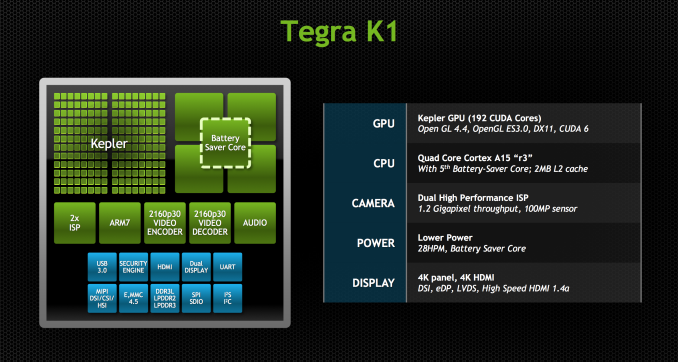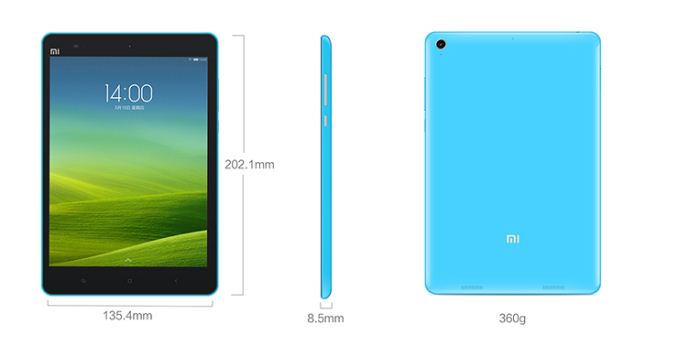Xiaomi Announces the MiPad: The First Tegra K1 Device
by Brandon Chester on May 15, 2014 9:40 AM EST
Today Xiaomi introduced its first tablet: the MiPad. The tablet bears similarity to both Apple’s iPad Mini and iPhone 5c. On the front of the tablet we have a 7.9” 2048x1536 IPS display (sourced from both Sharp and AUO Optronics) which is surrounded by an asymmetrical bezel. On the back we have a plastic shell of multiple different colors which Xiaomi itself states is made with the same injection molding technology as the iPhone 5c. There is also an 8MP Sony camera on the back with an F/2.0 aperture, and a 5MP camera on the front. The most interesting part of the Mi Pad is not on the outside, it's on the inside. The MiPad is the first consumer device to be announced that is powered by NVIDIA's Tegra K1 SoC.
As you may recall, NVIDIA introduced Tegra K1 to the world at CES 2014. It marks a huge departure from NVIDIA's mobile graphics strategy, abandoning the old Tegra GPU roadmap in favor of its desktop Kepler architecture.
Tegra K1 has two flavors, both built on a 28nm HPm process. One uses NVIDIA's Project Denver which will include two custom ARMv8 cores designed by NVIDIA. Denver is not slated to ship until later this year and so what we see in the MiPad is the other flavor of Tegra K1 which is a quad core ARM Cortex A15 design. Similar to other recent Tegra SoCs, this version of the K1 features four Cortex A15s plus an additional companion Cortex A15 optimized for lower frequencies for periods of low CPU usage. The CPU cores are based on a newer revision of Cortex A15 (r3p3) which includes finer grain power gating to reduce power consumption compared to revision r2p1 in the Tegra 4. This increase in efficiency will help balance out NVIDIA's move from a 1.9GHz max clock speed on Tegra 4 to over 2GHz on Tegra K1 (the move to 28nm HPm should help as well). The Tegra K1 SoC in the MiPad will ship with a max clock speed of 2.2GHz and 2GB of LPDDR3 RAM.
The GPU on Tegra K1 is something completely different from previous Tegra designs. Previous Tegra chips integrated NVIDIA's GeForce ULP core designed exclusively for its mobile platforms. With Tegra K1 Nvidia abandoned the idea of having a separate mobile roadmap for GPU designs and has merged its mobile and PC GPU roadmaps. The result is that Tegra K1 and all subsequent designs will ship with GPUs using the same architecture as NVIDIA's PC parts. With Tegra K1 we get a complete implementation of NVIDIA's Kepler architecture with 192 CUDA cores, 4 ROPs, and 8 texture units. It also brings along OpenGL ES 3.0, OpenGL 4.4, DirectX 11, CUDA 6.0, and every other API that Kepler supports.
NVIDIA has also shown a commitment to releasing software that will take advantage of their mobile GPUs. The company recently worked with Valve to bring Half Life 2 and Portal over to the NVIDIA Shield which is powered by a Tegra 4 CPU and I am sure that crafty users will bring the apps over to Tegra K1 devices if NVIDIA does not do so itself.
Beyond the SoC, the other internal specs for the MiPad include a 25.46 Whr (6700mAh) battery, 16 or 64GB of internal NAND, and a MicroSD slot. Connectivity includes support for 802.11 b/g/n/ac and Bluetooth 4.0. As with other Xiaomi devices, the MiPad runs Android with the MIUI UI atop it. It will launch in China sometime in June priced at 1499 yuan ($240) for the 16GB model and 1699 yuan ($272) for the 64GB model.












82 Comments
View All Comments
Spunjji - Friday, May 16, 2014 - link
Thanks for that. Your actual experienced input is an unusually valuable insight in a comments thread.GC2:CS - Monday, May 19, 2014 - link
If your numbers of power compustion you calculated are relevant it looks bad with tegra... But the problem is not in power compustion of the SoC itself, but those numbers of battery lifetime.Honestly I don't want to embarrass you here on a forum but it looks like you have problems with the basics of physics. So let me explain... Work made by electricity is the electrical current multiplied by voltage (P=U*I). What that means is that you can't make any specific battery run time numbers if you don't know the current flowing trough your electrical machine ( tegra in this case) or battery capacity in Wh, you just can't divide the current and work and get time (or whatever you did).
So how to fix this, I know that 99.9 percent of batteries in tablets have 3.7 V nominal voltage. That means the work they can do from full charge to zero charge is this voltage multiplied with the current. So we got those 6.5 Ah battery (6500 mAh) at estimated 3,7 V. That works out to be about 24.05 Wh.
Now we can divide this number with power compustion of your electrical machine and we got about 40 hours of idling, 10 hours 59 minutes of web browsing and 5 hours 5 minutes of gaming *just for the SoC and RAM alone*. Yeah It's very bad especially if we compare this to the incredible efficiency of the A7. And I don't think nvidia will take over with this kind of power compustion like it was written in a very long post above.
jjj - Thursday, May 15, 2014 - link
"Today Xiaomi introduced its latest tablet: the MiPad"Its first tablet not its latest and worth mentioning that the wifi ac is supposed to be 2x2 and those benchmarks they shared look interesting. Too bad for the moronic AR.
kwrzesien - Thursday, May 15, 2014 - link
Holy Batman! A 48GB storage upgrade for $32! Please Apple, bring us some love in the next round of devices.Flunk - Thursday, May 15, 2014 - link
Won't happen until the market demands it. As long as people pay the stupid prices, they stay stupid.supgk - Thursday, May 15, 2014 - link
But can you run apps from that storage?Morawka - Thursday, May 15, 2014 - link
yes you can. KitKat supports "move to SD card" feature which moves all of the app's assets to the card and runs them from it.tviceman - Thursday, May 15, 2014 - link
I so wish this would come stateside. :(Devo2007 - Thursday, May 15, 2014 - link
nVIDIA introduced Tegra K1 at CES 2014, not 2013.Brandon Chester - Thursday, May 15, 2014 - link
Just fixed that up, thanks for pointing that out.